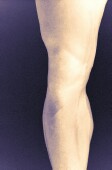
WEDNESDAY, Nov. 20, 2013 (HealthDay News) — Poor circulation in the legs, a condition called peripheral artery disease (PAD), affects many Americans and can become so serious it leads to amputation.
But a new study finds wide hospital-to-hospital variance in spending on PAD, with no significant difference in amputation rates.
“Medicare spending on patients with severe PAD varies more than twofold across the United States,” wrote a team led by Dr. Philip Goodney of the Dartmouth-Hitchcock Medical Center.
In background information in the study, the researchers noted that in recent years, care aimed at preventing amputation has become increasingly costly due to the rising use of less-invasive “revascularizations” — treatments used to improve blood flow. According to Goodney’s team, hospitals in regions that spent the most on PAD patients often ordered these lower-limb treatments in the year prior to an amputation.
The researchers analyzed data from more than 18,400 Medicare patients who underwent major PAD-related amputations between 2003 and 2010. The average cost of inpatient care in the year before amputation was $22,405 per patient. This included the costs related to amputation.
However, there was wide variation in regional costs, ranging from $11,077 in Bismarck, N.D., to $42,613 in Salinas, Calif., according to the study published online Nov. 20 in the journal JAMA Surgery.
The study “offers little evidence to suggest that more expensive vascular care offers a marginal advantage over less expensive vascular interventions,” Goodney’s team concluded.
Two other heart experts stressed that the care of patients with PAD — who often have other illnesses such as diabetes or heart failure — is complex, and the new study might not tell the full story.
“This study should not suggest that leg revascularizations are useless,” said Dr. Jeffrey Berger, a cardiologist at NYU Langone Medical Center in New York City. “A leg revascularization could have other beneficial outcomes that this study did not investigate, such as improvement in quality of life, or [it could] affect the type of amputation that might be required,” he said.
Dr. Maja Zaric is an interventional cardiologist at Lenox Hill Hospital in New York City. She said that better and more rigorous trials are needed to investigate the issue. The current study “looks only into the Medicare population and analyzes only inpatient cost, which underestimates real and overall costs,” Zaric said.
She also believes that people in the more “expensive” group may have been sicker, with more co-existing illnesses. These illnesses, such as heart failure, kidney failure and heart disease, “do affect PAD course and progression, as well as the treatment success,” Zaric noted.
Finally, she added, treating patients at specialized vascular centers “that involve easy access to diagnosis, treatment and wound care [might be the place] where both procedural success and cost effectiveness will come together.”
More information
The American Heart Association has more about peripheral artery disease.
Copyright © 2025 HealthDay. All rights reserved.

